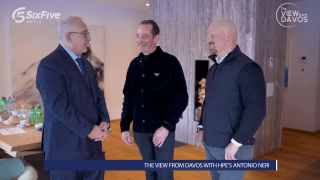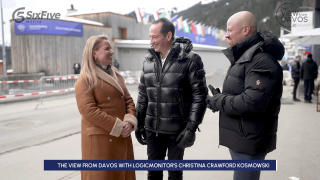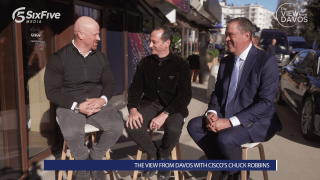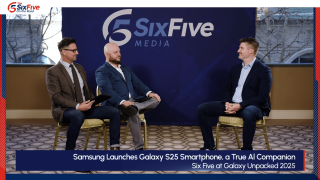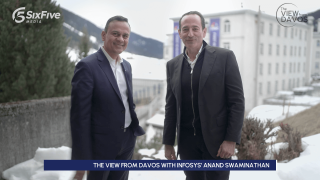The Six Five is “On The Road” with VAST Data‘s CEO, Renen Hallak at their HQ in NYC. Hosts Daniel Newman and Patrick Moorhead discuss their upcoming “Cosmos” event, VAST Data’s role in AI and how AI is reshaping society and business, offering efficiency gains and customer benefits, but also presenting new challenges. Stay tuned as Vast is aiming to deliver the OS for AI.
Their discussion covers:
- The evolution of VAST Data and its mission in the AI landscape
- Breakthrough technologies that are driving AI advancements at VAST Data
- Real-world use cases and customer success stories
- The importance of data infrastructure in scaling AI applications
- Future directions for VAST Data in AI and data storage
Register here: VAST Data – Enter the Cosmos
Watch the video below, and be sure to subscribe to our YouTube channel, so you never miss an episode.
Or listen to the audio here:
Disclaimer: The Six Five Webcast is for information and entertainment purposes only. Over the course of this webcast, we may talk about companies that are publicly traded and we may even reference that fact and their equity share price, but please do not take anything that we say as a recommendation about what you should do with your investment dollars. We are not investment advisors and we ask that you do not treat us as such.
Transcript:
Patrick Moorhead: The Six Five is On The Road, here in New York City at VAST Data’s world headquarters. And unsurprisingly, we are talking about AI. So many different types of conversations, so many different questions from CEOs, CIOs, and everywhere in between. But one of the things that absolutely is true, and yes I did call this more than a year ago, was that the key part was going to figure out how to deploy this and make this operational. Not only in the public cloud, but on-premises, where most of that data sits. Because, Dan, as we know, 80 to 85 percent of that enterprise data is either on-premises or on the edge of the enterprise.
Daniel Newman: Yeah. We hear a lot about the cloud. Right now, we have real complexities that live inside of enterprises. They’re trying to figure out what their operating system is for their data, how they’re going to manage it, how they’re going to deploy it, how they’re going to make it accessible. Pat, the word on the street, the buzz on the street is we’re having this great infrastructure build out. It’s a really exciting time, if you’re in the AI space.
But we also have companies in every industries that are hungry to understand how AI can help them be more productive, more efficient, and how this can be done now. Because right now, companies are up against it. It’s tough out there. While markets are new highs every single day, that’s not all companies, that’s not all businesses. AI is very deflationary and it’s going to help drive a lot of businesses forward.
Patrick Moorhead: That’s right. One thing we’ve seen architecturally is you have to have multiple parameters in alliance. You have to have your compute. You have to have your networking. You have to memory, and you have to have the right storage and data in alignment to get everything done efficiently. One company, here we are, with VAST Data, has been very architecturally focused on getting the most efficiency out of everything they do by collapsing multiple elements of the data and the storage tier. Super exciting. To talk about AI and all this awesomeness, I here with the CEO of VAST Data. Renen, welcome to The Six Five.
Renen Hallak: Welcome to our office.
Patrick Moorhead: Great to be here.
Daniel Newman: Thanks so much for having us. Over the years, you and I have had a few different chances to sit down. It’s great to have you, for the first time, here on The Six Five with both Patrick and I. You heard the preamble. We’re droning on a bit. But I think the AI story has captured the minds, and risen into the consciousness of everybody worldwide now. It’s been an absolute tailwind for VAST. I’ve been watching the company. New raises, new strength in valuations, growing revenue streams. Like I said, always loved that you were a company that never needed to raise because you had a business that always knew how to make money. I loved that. But give me a little bit of a taste of your feel on the AI story that we started off with here. Why is this such a big moment? Why are people so excited? Talk a little bit about societal impacts, business impacts of what you’re seeing.
Renen Hallak: Well, I think societal impacts, it depends on how far we can stretch this. If we can really take AI to where everybody hopes it will be, then it will solve the problems that we don’t know how to solve around disease, and climate, and energy, and space travel. The things that we are struggling with as people, if we have a much smarter friend that can help us achieve those, then it’s a much more exciting and interesting future than we would have otherwise had. From a business perspective, we’re seeing a lot of efficiencies. We’re not seeing them yet, but we’re seeing the potential for these efficiencies. Where AI can augment a lot of the people, and do things in an automated way where we couldn’t before.
Patrick Moorhead: Yeah. It’s like every major transition that I’ve seen in technology, and that I’ve read about that I wasn’t around for. The system breaks at the seams. We’re overpowering the current way that we do things. Right now, what I’m sure you’re hearing as well as we are, for enterprises it’s very expensive. We need efficiency. It’s sucking an incredible amount of power. Are these similar things or challenges that you’re hearing from your customers? If they are, I’m curious what you’re doing about that?
Renen Hallak: Yeah. Whenever there’s a new technology, the first step is to see that it works. Then the second step is to see how do we do it efficient? I think we’re at the point where we understand that it works. Obviously, everyone has witnessed ChatGPT. We don’t know how far we can stretch it. But in parallel to figuring that out, we need to make it a lot more efficient. We’re seeing that happen all across the board. What we try to do at VAST is we don’t know anything about the hardware layers, we don’t know anything about the application layer. We’re right in the middle. The middle of the sandwich that’s soft, where infrastructures stack, trying to build the operating system, if you will, that allows these new abilities to be widespread. Not just in a handful of companies, but across clouds, across enterprises. Make it easy for everybody to adopt this in an efficient manner.
Patrick Moorhead: Yeah. Generative AI brought a lot of new challenges as well. One of those, and we talked a little bit about this in the preamble in the green room, is people wanting to bring data together that hadn’t previously been brought together. Enterprise-wide access to this data, that is a challenge because they don’t have it today, do they?
Renen Hallak: They do not. Nobody ever thought that computers would be able to analyze these types of data. We’re used to computers analyzing numbers, and rows, columns of a database. Not pictures, not video, not sound, not natural language. So no one’s prepared. Now we need to understand what data we have, and we need to tie the data with the computer in a way where we can unlock its value. That couldn’t be done before.
Daniel Newman: It’s happening very quickly. We’re seeing, Renen, just incredible innovation. Of course, you’ve been one of the beneficiaries. Companies are, to your point, they’re up against figuring out how to remove complexity. I remember talking to you early on, and you had this belief that tiered storage as it existed wouldn’t exist.
Renen Hallak: Yes.
Daniel Newman: That was your whole premise. It was very fortuitous because, at the time, there wasn’t ChatGPT. Somebody knew about ChatGPT, but most of us didn’t.
Renen Hallak: Right.
Daniel Newman: There wasn’t generative AI. There was still a lot of machine learning and data science. You were seeing that at the time. You knew AI would be a big trend. You knew that ML, neural networks, this was what was going to change structurally.
Renen Hallak: Yeah.
Daniel Newman: Also though, you’ve been very customer obsessed. Part of what’s made VAST so successful is that you’ve really stuck close to these customers. They’ve come to you with a unique challenge. They’ve said, “I can’t get what I need elsewhere. We want to get it from you.” Talk a little bit about the challenges that you’re helping them face, but really the other challenges that are keeping them up at night. Because if I was running IT, or even a business right now, and digitally transforming a company right now, I don’t know how well I’d be sleeping.
Renen Hallak: I think those things come together. The fact that we were able to see the future, the fact that we were able to see AI ahead of others is because of our customers. We were very, very lucky in the early days to partner with hedge funds, and life science institutes, and autonomous driving vehicle companies, and government agencies that were all on the bleeding edge of AI. They weren’t large language models yet, but they were definitely pushing the envelope. They were telling us where the future would be and where the challenges would lie. We solved for them, three years ago, four years ago, five years ago, the challenges that today, everybody else is starting to face. What we’re seeing as challenges are …
Well, there’s two types of companies out there. There are the ones that have been doing AI for a while, and are knee-deep in it. We are helping those companies build larger and larger clusters, larger and larger deployments. We have customers today at the exabyte scale, with hundreds of thousands of GPUs across multiple sites. VAST is the fabric that allows them to make sense of it all. Then on the other end of the spectrum, we have enterprises that haven’t started down this AI journey yet, that are still trying to figure it out. But what they know is that the first step in figuring that out is getting their data in order. Putting that data on a system that makes it accessible, that makes it understandable, that makes it possible for them to leverage under new AI workloads down the road is the first step down that journey.
Daniel Newman: No, I was just going to say it’s really interesting is they started down the road … Remember we did the Flops to Tops?
Patrick Moorhead: Sure.
Daniel Newman: He’s talking about the customers.
Patrick Moorhead: I remember seeing him dressed up as a-
Renen Hallak: Well, they’re leading-edge customers you’re talking about.
Patrick Moorhead: Super computing.
Renen Hallak: Yeah.
Patrick Moorhead: It all started with those that were building out super computers to do this, and now it’s become way more mainstream.
Daniel Newman: By the way, you should see this guy when he’s dressed up as a full astronaut. I may have seen that in one of your pictures.
Patrick Moorhead: VAST DataSpace.
Renen Hallak: Right.
Patrick Moorhead: There we go. I loved that. Another conversation, I eluded a little bit to it in my open, was location. You have some customers who want to go to a CSP. You have others that might want to do co-lo. Some other want to do on-prem. And some want to do the public cloud. What are you hearing related to industrial enterprise strength AI with the location?
Renen Hallak: Well, I think it depends on who the customer is and what they’re doing. Training requires very, very large clusters. Inference requires being at the edge, close to where the users are, low latency.
Patrick Moorhead: Right.
Renen Hallak: Enterprise customers want more control over their data. Young startups don’t care about that as much. What we’re finding is that, for the first time since the big public cloud started, it’s being disrupted. There is a new class of CSPs now, regional AI clouds. What they’re doing is they’re building a new type of data center. They’re filling it up with new types of hardware from companies like Nvidia. Then they need that software infrastructure layer on top for them to be able to offer cloud services, and that’s what we provide. Another thing that we came out with relatively recently is what we call the VAST DataSpace, which allows us to run VAST instances in large public clouds, in regional AI clouds, at the edge, in the enterprise, and stitch all of those instances together into one global main space. Where you no longer care where your data actually is, you can access it from wherever you’d like. That fixes that problem of geography.
Patrick Moorhead: No, I love that. I’m a huge fan. I brought this up on the show for probably two years, this idea of a hybrid multi-cloud fabric. Which is location is less important than the fabric that binds it all together. I love that. You’re unifying data, not only inside of a specific enterprise and a specific location across different data types, but also across different locations for the same customer.
Renen Hallak: Yeah.
Patrick Moorhead: I love that, Dan.
Renen Hallak: And across customers. We have customers that want to collaborate with each other, and they want to share data, or not share data.
Patrick Moorhead: Right.
Renen Hallak: You can do that once this DataSpace is out there. As you said, different types of data. We’re talking about pictures from an autonomous driving car, and then we’re talking about the metadata that is inferred from those pictures. Both the unstructured piece and the structured piece can now sit together within the same platform.
Patrick Moorhead: Intra-customer, cross-customer, location independent.
Daniel Newman: Yeah, it’s very interesting. I’m glad you mentioned these new CSP, because I know we’ve been paying a lot of attention to this. For nearly two decades, that industry has been somewhat undisputed, but definitely not disrupted. Interestingly enough, only got to about 25% market saturation at the point in which this new type. Of course, I think they’re going to be very successful, where you pointed out, young companies, companies that don’t have large cloud deployments.
But I also think, with multi-cloud being successful, there will be a lot of companies that might keep traditional compute with a traditional public cloud hyper-scaler. They make look to some of these new AI hyper-scalers. That’s what I like to call them. It’s been very interesting to watch how that will mature. I’d like to do a little bit of a recap here. You’ve said a lot. When you really simplify it, can you give me the one, two three? What is the bang-bang of what VAST is really doing to enable and help its customers move more rapidly?
Renen Hallak: We built the new architecture. That architecture allowed us to break the fundamental computer science trade off between price, and performance, and scale, and resilience, and ease of use. That is what is driving this next level of AI. If you look at any historical technological revolution, if you will, it was always the hardware that came first that enabled the revolution. It was always the software layer, the operating system that made it widespread. That made it easy to use. That made all of us able to use a phone or a computer. The same thing needs to happen for AI. It cannot stay in the realm of, like you said, research centers. It’s not going to remain high performance compute. It is going to shift into the enterprise by us making it simple for everyone to use. That’s how we do it. We take away all of the complexity and let you focus on your business, your application.
Daniel Newman: Hard question. At least, I think it’s a particular question.
Patrick Moorhead: But not hard for Renen.
Daniel Newman: Hard for me. Great success, great run, customer adoption. You’re in an industry of formidable challengers. They may not do what you do, but the people that you’ve competed with, and the people that you’ve been very clear don’t do what you do, why aren’t they doing what you do, seeing the momentum that you have? Because it seems that, even after a few years gaining momentum, gaining customers, gaining traction, gaining value, why is this so hard?
Renen Hallak: I think it goes back to that architecture, and it goes back to when did we start. When we started, we were able to see this deep learning revolution. It was the very first phases of it, but it was clear that more data, more access to data will enable better and better results. Interestingly, we were founded on the same month as OpenAI. We were walking parallel paths. Them, obviously at the application level, us at the infrastructure layer. You can’t do what we did by retrofitting an old system. You have to start from scratch.
The older companies that came before us have a hard time throwing away everything that they’ve built and starting a new thing. Newer companies, I think, will be the ones that build it. We haven’t seen many of those. Mainly, because the starting point was a storage system. Storage is not sexy. Storage is not attracting VC funding at this point in time. That has allowed us, I think, to stay for a longer period of time than one would have expected without direct competitors.
Patrick Moorhead: Yeah. You had the foresight on the downstream type of requirements for this new type of model, you set that in there. Listen, any new startup who can come out and just start off with no baggage architecturally has an advantage. It’s also a little bit of a challenge until you get liftoff. You certainly had liftoff here. You nailed it. Nailed it when you came out in 2019. I’m curious then, we’re going to come out a little. What are going to be the characteristics of the companies who are going to lead and win in the AI space? Obviously, they’re going to be different, but what do they look like?
Renen Hallak: I think it’s companies that think AI first. We had that advantage of starting late, that we could see the requirements and the problem. We also have the advantage of being able to leverage underlying technologies that didn’t exist before. It’s a double advantage, if you will. Anyone who thinks from that point of view of what do these new workloads require? Whether it’s training, or fine-tuning, or inference. How do these things collide? How do we get feedback loops from humans? How do these AI agents start to interact with each other? In order to build up on each other. How does this AI that we have today build the next generation of AI that’s better? In an ever-recursive loop, you need to start thinking very differently in order to cater to these new challenges, versus where we were 10 and 15 years ago.
Patrick Moorhead: Ecosystem has always been important, at least for the last 20 years. I could say, 30 years ago, monolithic companies. Interestingly enough, we see monolithic, big, giant companies. I’m curious, how important is ecosystem? Is it more important, less important in this new age of generative AI?
Renen Hallak: I think it’s more important. I think no one can do it on their own. I think you are seeing a new generation of companies emerge. These new companies need to work together in order to build a full solution. You mentioned the new AI hyper-scalers. They’re part of the ecosystem. Obviously, the hardware providers are part of the ecosystem. Data center providers, power companies. It’s surprising what you need in order to be successful in this new world. You mentioned integrators and consultants in order to help enterprises understand these new words, in some cases. I think it takes a full ecosystem of partners in order to build it. We want to be a small part of that. We want to be an important part of that.
Patrick Moorhead: Yeah, I agree. The past 40 years, the industry goes through these disaggregation and aggregation moments. It feels like we’re getting into a disaggregation moment. Now I can put LLM training on the side, because that requires very large-scale systems. But it does look like we’re getting back to where more innovation through disaggregation, and partnership becomes key to bolt it all together in the most efficient way possible.
Renen Hallak: Yeah. It’s been made clear that there’s a new ability. Now money is pouring in, and innovators are coming in order to build new companies, and new abilities around this new technology. It’s very hard to predict what the world will look like five years from now.
Daniel Newman: Well, we saw the take a village moment. Actually, moment, after moment, after moment, as Jensen Huang went on stage, after stage, after stage, to the point of ecosystem. The prediction is if this is the OS for AI, are we going to see Renen Hallak, CEO of VAST Data on stage, after stage, after stage next year? I know you’re working on some really interesting things. I know you guys, because of where you sit, sometimes don’t always get to make the cool announcements. I can’t say anything to y’all, but I know you’re involved in some pretty cool projects. I envision you guys are just at the beginning of seeing some of the big opportunities that VAST has.
Renen Hallak: I think so. I think the center of gravity is shifting a little bit, as we move from large language models to multi-modal. As we move from the first phase, which was all around compute, to the second phase, which is around accumulation of more and more data, we are becoming, I believe, more important in this ecosystem than we were before. I don’t know that my style is to go up on stages, but definitely we love to enable the innovators. I think the most interesting projects that are happening today in the world around AI are leveraging the VAST Data platform.
Daniel Newman: Well, congratulations on that. Any final, closing remarks? I hear you have an event coming up. Tell us a little bit?
Renen Hallak: I’m not allowed to say anything. It’s in September. It will definitely be about our transition. We started as a storage company. Last year, we came out with our Build Beyond event, which announced to the world that we’re now a data platform.
Patrick Moorhead: Right.
Renen Hallak: That next phase is becoming that full-fledged operating system. We’ll talk a lot about that. Obviously, an operating system requires a lot of partnerships and a lot of other companies around us to build out the full solution. Hopefully, we have a few of those interesting collaborators on stage with us in September.
Daniel Newman: Well, Renen, thanks so much for joining us here on The Six Fix. I appreciate you having us here in your office, talking about what’s going on. It sounds like the journey is just getting start and it’s very exciting.
Renen Hallak: Thank you.
Daniel Newman: All right, everybody, hit that subscribe button and join us for all of our content here on The Six Five. It’s been a great conversation. Stay with us. We will have more info through The Six Five about that upcoming VAST Date event that Renen mentioned. We will be able to give some details, but not yet, not now. For this episode, for Patrick and myself, it’s time to say goodbye.
Patrick Moorhead: See you all later.


